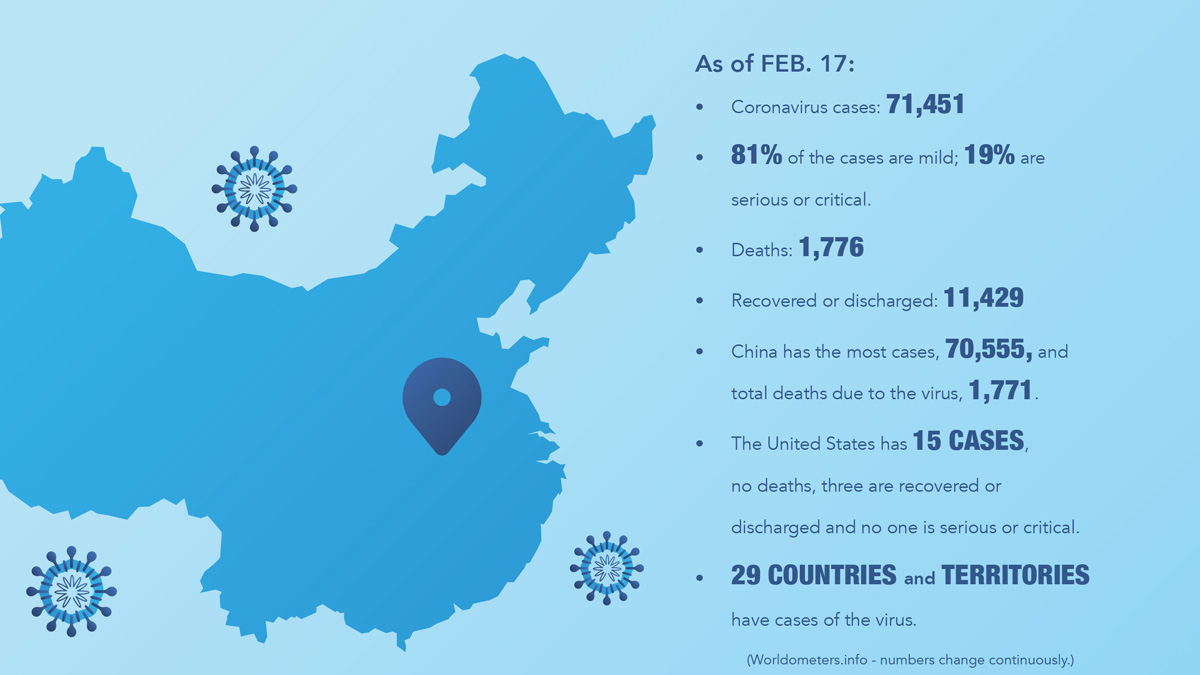The World Health Organization defines the coronavirus as a large family of viruses found in both animals and humans. The illness in humans ranges from the common cold to more severe respiratory illnesses. For some, the virus is mild, including a runny nose, sore throat, cough and fever. But it can be more severe and cause pneumonia or breathing difficulties, and, in rare cases, it can be fatal. The most vulnerable are older people and people with pre-existing conditions such as diabetes and heart disease.
The virus is spread primarily through an infected person’s respiratory droplets generated when the person coughs, sneezes or through their saliva or discharge from their nose. It is important to frequently wash your hands and sneeze or cough into a flexed elbow or with a tissue that is discarded immediately.
The highest risk for contracting the virus is for people who have recently traveled to China or who have been living or working closely with those travelers. Health workers caring for a person suffering from coronavirus are also at high risk.
It may be hard to determine the difference between the coronavirus and the flu or cold virus, but laboratory tests will confirm the diagnosis. The key is seeking medical care early if you experience cough, fever and difficulty breathing.
(Information gathered from the World Health Organization.)
- Coronavirus cases as of Feb. 17: 71,451
- 81% of the cases are mild;19% are serious or critical.
- Deaths: 1,776
- Recovered or discharged: 11,429
- China has the most cases, 70,555, and total deaths due to the virus, 1,771.
- The United States has 15 cases, no deaths, three are recovered or discharged and no one is serious or critical.
- The incubation period is two to 14 days.
- 29 countries and territories have cases of the virus.
(Worldometers.info)
- A quarantined cruise ship docked in Japan, the Diamond Princess, had a reported 454 cases on Feb. 17, with roughly 3,700 total passengers and crew on board. They were quarantined for almost two weeks before beginning to evacuate on Feb. 16.
- 300 Americans were evacuated from the ship, including 14 with coronavirus. When they arrived back in the United States on Feb. 17, they were quarantined for another two weeks at Air Force bases in San Antonio and Fairfield, California.
(CNBC)
- The CDC recommends that travelers avoid all nonessential travel to China.
- On Feb. 11, the World Health Organization announced an official name for the disease that is causing the current outbreak of coronavirus disease: COVID-19.
- Early on, many of the patients in the COVID-19 outbreak in Wuhan, China, had some link to a large seafood and live animal market, suggesting animal-to-person spread. Later, a growing number of patients reportedly did not have exposure to animal markets, indicating person-to-person spread. Chinese officials report that sustained person-to-person spread is occurring in China.
(Centers for Disease Control and Prevention)
- Among the infected are at least two newborns, according to Chinese health officials. But few children are among those sick enough to be diagnosed with the coronavirus.
- According to the data analyzed in that article — and numbers are changing quickly as the outbreak evolves — the median age of patients skews older, between 49 and 56 years old.
By Theresa Stratford
